Plainfield Country Club
NJ, USA
Green Keeper: Travis Pauley

More so than all but a very few Ross courses, Plainfield has genuine stand-out golf holes. Pictured is the green complex for the 145 yard 11th, perhaps Ross’s finest short one shotter.
While Donald Ross courses have been famously (or infamously) altered in order to host major championships, the vast majority of his courses haveendured more passive forms of change over the decades. Typically, it starts with overzealous tree planting,which reduces Donald Ross‘s wide fairways and compromise his intended playing angles. Fairways invariably get shifted to accomodate the tree growth,with one result being that many of Donald Ross‘s fairway bunkers become detached from the hole’s playing strategy. In addition, bunker facesare inconsistently maintained, with many acquiring flashed-up sand faces as opposed to their original grass face. Finally, Donald Ross‘s large-ish greens are allowed to shrink two to twelve feet around their perimeter, thus losing many of their more interesting hole locations.
The above is as true for Donald Ross courses in the middle of the country like French Lick and Beverly Country Club as it is to the south likeat Hope Valley Country Club as it is to such New England gems as Charles River CC and Metacomet Country Club.
Plainfield Country Club, which hashosted such national events as the the 1978 United States Amateur and the 1987 United States Women’s Open, had also fallen prey to the above, but unlike many clubs, Plainfield decided to do something about it.
Then Green Keeper Greg James started selectively restoring the bunker faces to their original grass faced version in 1995. Given his success, the Club broadened the scope of the renovative work. To that end, they conducted interviews with several leading architects who had previous experience in working on Donald Ross courses. They ultimately selected Gil Hanse Golf Course Design to prepare a Master Plan to address each of the points referencedin the opening paragraphand in 2000, the Club adopted Gil Hanse‘s detailed Master Plan.
While Donald Ross aficionados always applaud Donald Ross for his routings,the one here is a particular standout. For instance, as Gil Hanse points out, Donald Ross‘s varied use of the same ridge in the creation of thefirst green,sixth hole, seventhtee,ninth tee, and eighthhole is nothing short of brilliant. The course itself is built on a 21,000 year old glacial terminal moriane with the clubhouse occupying the highest point in Middlesex County. Donald Ross‘srouting over the property’s rolling hillocks yielded many singularly distinctive holes to the point where Plainfield doesn’t remind the golfer of any other Donald Ross course. Within the eighteen holes, thereare the threefirst rate starting holes, the mightyseventh which is one of Ross’s all-time best, the tiny one shot eleventh which many consider as Donald Ross‘s best sub -150 yard hole, and two sterling three shot holes on the second nine.
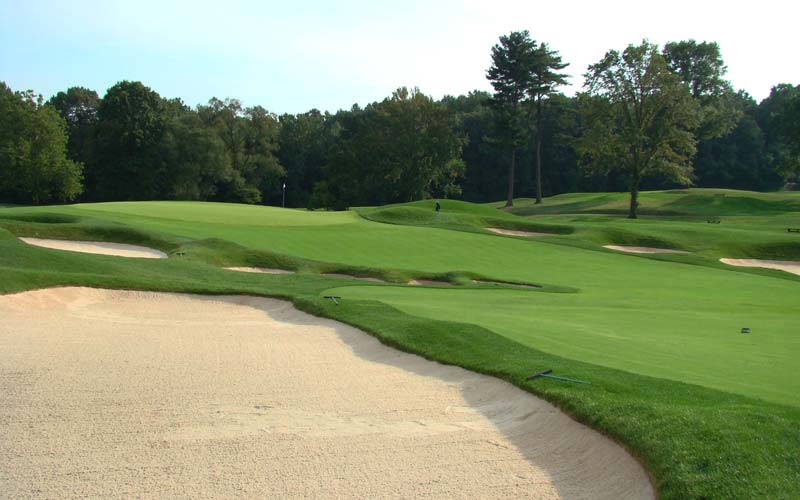
With the trees down, golfers better appreciate the rolling nature of the property and Ross’s imaginative bunker schemes. Pictured above is a view eighty yards from the second green while below…
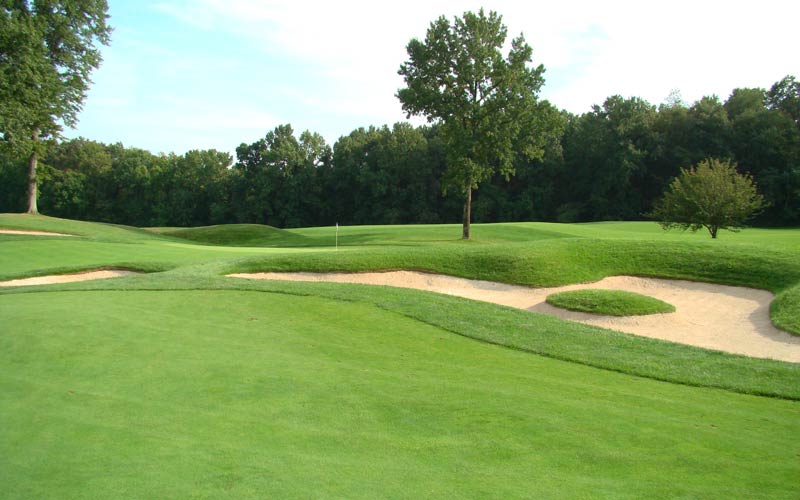
… are the bunkers that guard the semi-punchbowl seventh green.
Unfortunately, the evolution of a few of the other supporting holes tended to obscure the excellence of these standout holes. For instance, trees on the inside of the doglegfourth had ruined the strategic merit of that hole. Gil Hanse replaced the trees with bunkers and once again, if the golfer is willing to flirt with the bunkers and the nearby out of bounds, he will be rewarded with theidealapproach into the small, angled green. Further examples of improvements are numerous and some are detailed below.
Holes to Note
Firsthole, 430 yards; Not exactly a typical Donald Ross handshake hole as an opener, nonetheless this one makes for an inspired start as the holestretches past the clubhouse and across tumbling ground to the massive green in the distance. The 9,900 square foot (!) green is a one-of-a-kindfeaturing a vexing back right shelf and a fierce slope from back right to front left.
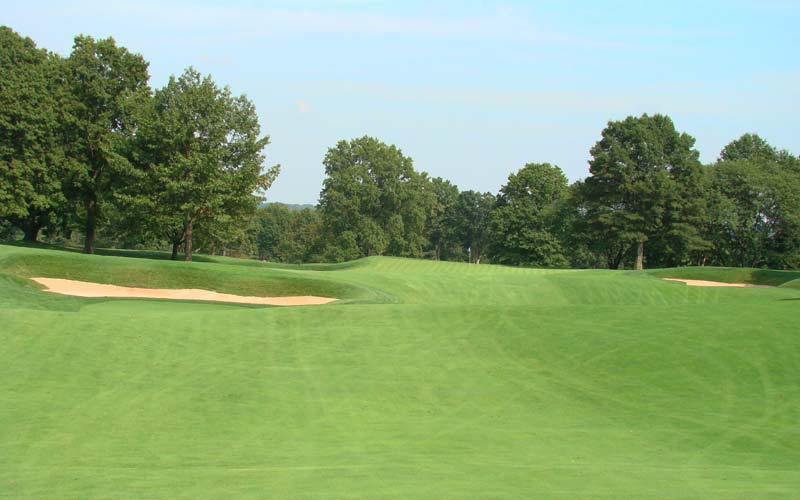
The old mowing pattern at one point ended at the right edge of the bunker, thus leaving it detached from play. Hanse shifted the first fairway mowing pattern ten yards to the left as per Ross’s final plans. The ideal angle into the back right to front left pitched green is once again from near this bunker.
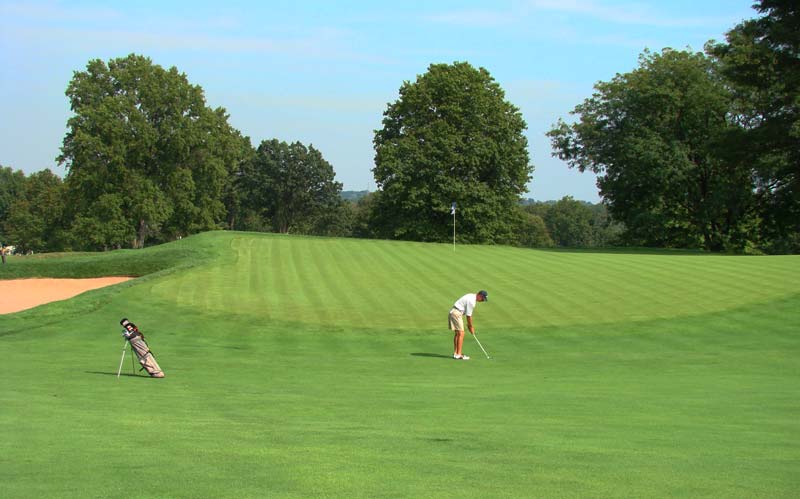
This golfer’s approach shot hit twenty-five feet up and to the right from where he is chipping. The day’s hole location would have been in rough ten years ago.
Secondhole, 445 yards; Tree planting was particularly popular in the northeast of the United States in the 1960s and 1970s and Plainfield was not immune to this phenomenon. Its effect on thesecond hole was two fold. Firstly,the trees planted along the fairway masked the rolling nature of the property by giving it an enclosed feeling. Secondly, several trees were planted directly behind the green whichaided the golfer with depth perception.Following Gil Hanse‘s advice, the Club removed such ornamental trees and with no trees behind the green, the golfer is more keenly aware of how the green is perched on a knob and that to go over the green is to court a double bogey.

Once shrouded in trees, the second now enjoys a more expansive feel thanks to the intelligent tee removal program that has seen 1,200 trees felled in the past decade.
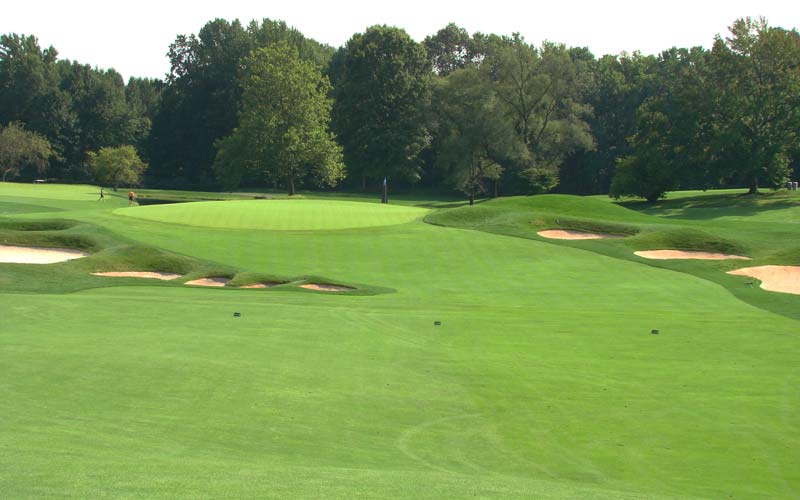
However, such is the rolling nature of the land that this string of bunkers isn’t evident from second tee. The remaining trees behind the green are a full sixty yards behind it. In fact, a view of the distant third green wasn’t afforded in 1990, so thick where the trees that framed the green. Note the tight chipping area to the left of the green. It extends down the hill to the left and recovery from it is quite ticklish.
Thirdhole, 180 yards; The end to what the author considers as Donald Ross‘s toughest three hole opening stretch, the pond to the right forces many players to bail left, which is precisely where Donald Ross hid a seven foot deep bunker. The resulting recovery shot back toward the pond across the left to right sloped green is not what the golfer was hoping foron the tee.

If left of the third green looks like the safe play off the tee…
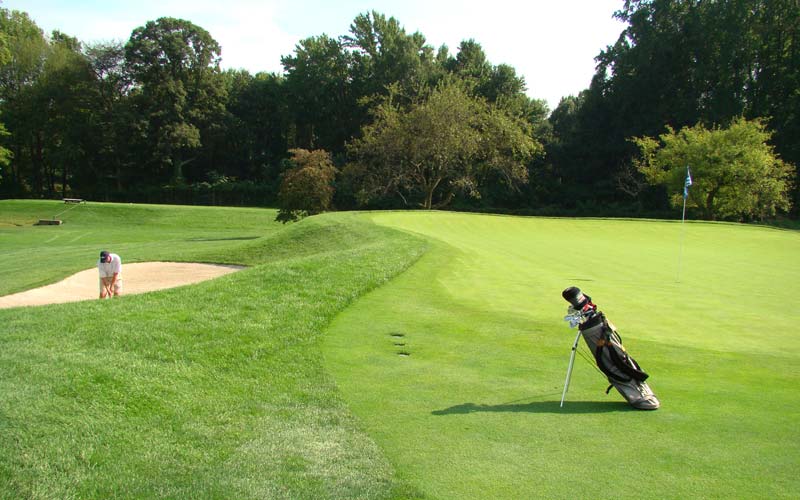
…think again! Short and left (i.e where the golf bag is) leaves the best chance for an up and down.
Fourth hole, 355 yards; Literally, an historic hole as the battle of the Short Hills was fought here during the Revolutionary War. Golfers have a battle on their hands of their own as this little brute plays far tougher than its yardage suggests. This hole has benefited as much as any hole on the course from the restoration as it had ceased to function properly. In the early 1990s, trees walled off the inside of the gentle dogleg and effectively prevented golfers from being able to seek the optimal place in the fairway from which to approach the green. Gil Hanse felled the trees and replaced them with three bunkers as per a 1930 aerial. Golfers are now free to seek this one flat portion of the fairway to have the best angle into the small angled green. Golfers who shy away from these bunkers are left with an awkward angle from in a bowl that is well below the putting surface. Along with the short eleventh, this hole yard for yard requires the most precise hitting on the course.
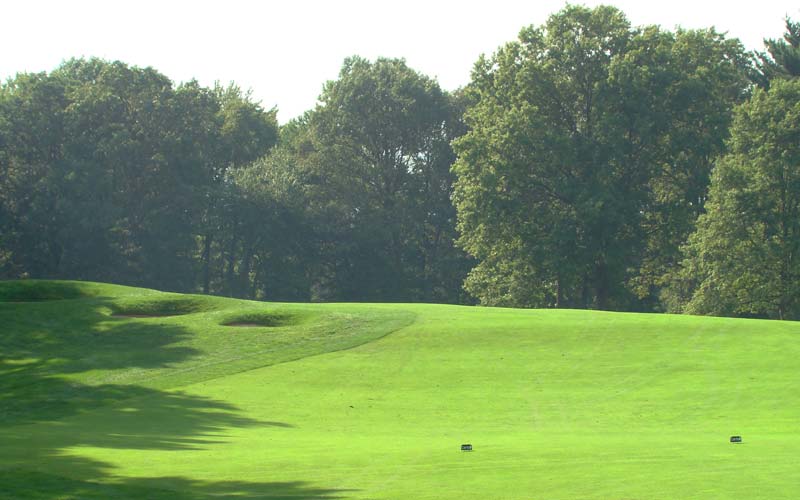
The new bunkers at the crest of the hill guard the optimal place for one’s tee ball.
Sixth hole, 165 yards; Thisis the sort of fun hole that manymodern architects struggle to design.Set across some of themore modestproperty, its five bunkers and sloping green provide its enjoyableplaying qualities. When faced with a similar situation, too many modern architects turn to artifical water hazards as a way to lend such holes character.

Hanse’s Master Plan called for the reinstatement of these two short bunkers sixty yards prior to the green complex. Cut into a ridge, they not only create depth perception problems but serve to remind golfers that they are playing a Golden Age course.
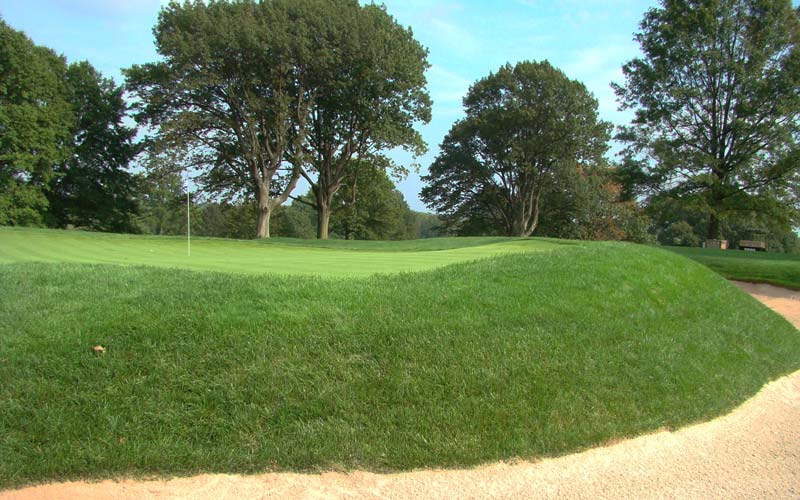
Note the green’s right hand ‘kick board.’ The tee ball that finished just left of the hole hit this kick point and sweep along the green’s right to left slope before finishing close to the hole. Seeing the ball disappear behind the high bunker shoulder only to reappear and loop behind the hole is always great fun.
Seventhhole, 470 holes; Many member’s favorite hole on the course, thanks to its gem of a green complex. Donald Ross cut a uniquely shaped bunker into a ridge and then placed the punchbowl type green ninepaces beyond it. The challenge of just carrying the bunker and then watching the ballroll across the green remains a joy to this day. North of the fourth hole at Seminole, there aren’t many Donald Ross two shotters better than this one.
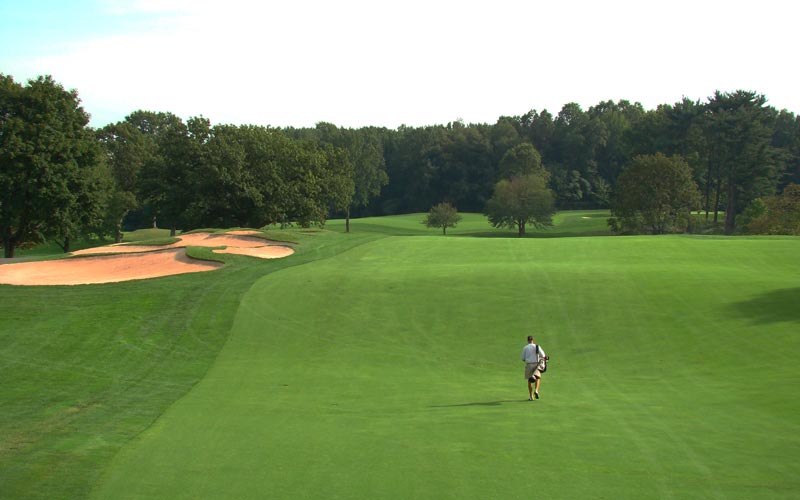
The scale of some of Plainfield’s rolls are clear against the six foot three inch golfer above. A good drive to the flat plateau leaves the golfer with…
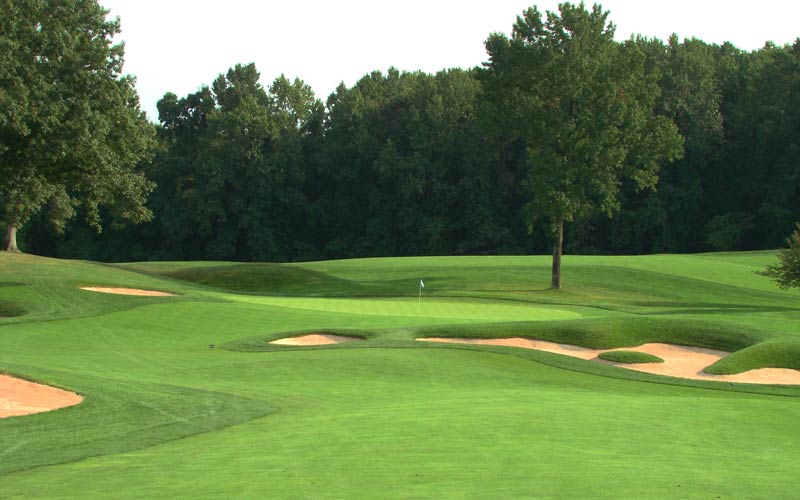
… this most memorable approach shot. The distinctive bunker pictured above is nine paces shy of the green but…
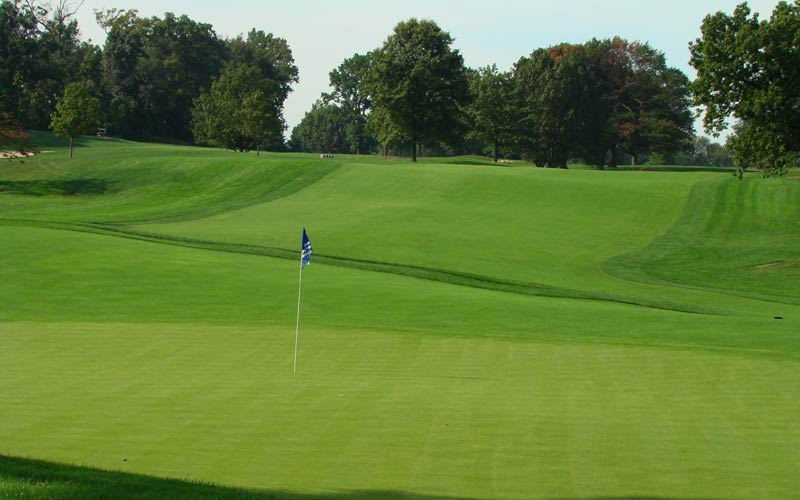
…the ground feeds down onto the putting surface if the golfer can just clear the bunker with his approach.
Ninthhole, 370 yards; A wonderful close to the front side, theninth traverses up the slope that thefirst hole tumbles down. Depending on exactly where one places his drive, the approach to the green can be blind and the golfer will have to select a particular mark on the clubhouse directly behind the green as his aiming guide. A pity more American courses don’t follow the U.K. lead and have holes that end directly beneath the clubhouse.
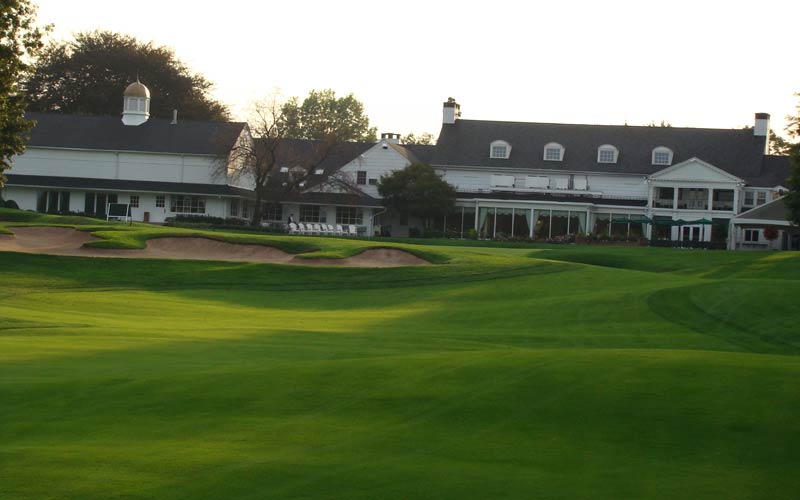
The cozy setting of the ninth green attracts many onlookers.
Tenthhole, 365 yards; Perfectly capturing the rolling topography of the site, the blind drive is over a ridge to a fairway somethirty feet below the tee. The angle of the steeply pitched green is toward the outside of the dogleg and as such, the golfer is better served bytaking plenty of club off the tee.A 240 yard tee ball gives the golfer the best view of the green whilethe ‘safer’, more conservative teeball of only 200 yardsleaves the golfer with a poor angle, as well as a blind shot, into the green. Few modern architects would have left the topography in its untouched state for fear of the howls of protest about the unfairness of blind shots.
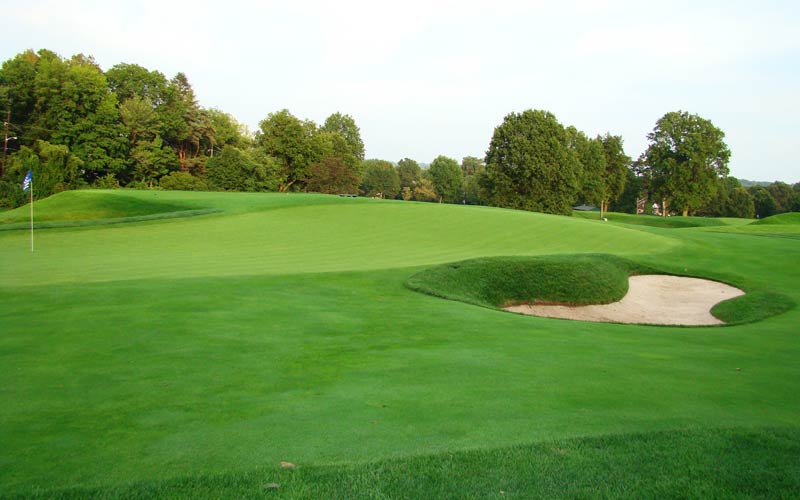
The long slender tenth green points toward the outside of this dogleg right from where approach shots are best played. The maintenance meld from the putting surface up to the back markers for the eleventh hole is excellent.
Eleventhhole, 150 yards; A strategically timelesslittle hole that plays from a tee that was perfectly benched into the hillside across a valley to a beautifully draped green on a ridge. Long is dead while short means that the golfer is likely to find himself in one of the deepest bunkers on the course. The green is thus a hit it or else proposition, which is reasonable given the hole’s modest length. No matter what happens with technology, this hole will forever retain its challenge.

The view from the eleventh tee may be more charming than terrifying…

…until one misses the green!
Twelfthhole, 590 yards; Originally a par four and a par three,Ross combined them into a three shot hole in the 1930s when the Club acquired additional land for the construction of new holes (today’s thirteenth through fifteenth). By doing so, he made excellent use of a drainage ditch which breaks into the fairway from the right at the 135 yard mark and bisects the fairway until it hugsthe green’s left side.Given a normal green, the golfer would rarely think of crossing thedrainage ditch with hissecond shot as the reward wouldn’t be worth the risk. However,a spine in the middle of the green runs from front to back and if the day’s hole location is left middle or front, the optimal angle into such hole locations is from the right hand portion of the fairway. The golfershould note thetwelfth’s hole location as he plays the nearbythird hole.
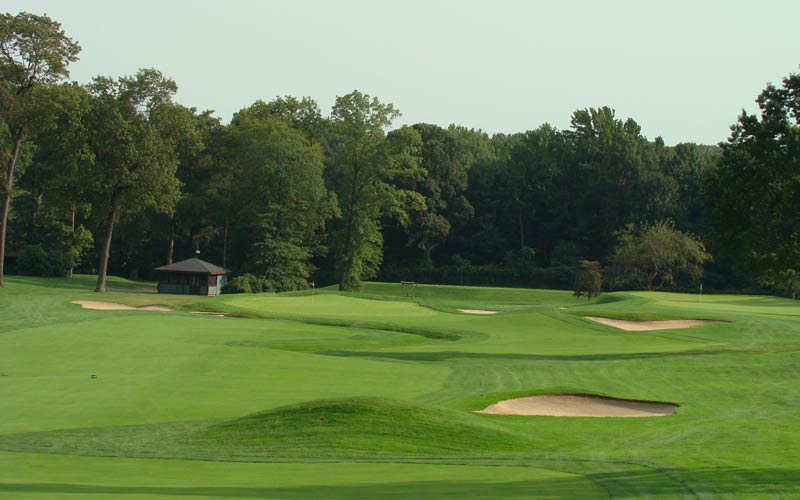
The drainage ditch coupled with the spine in the green creates interesting decisions for the golfer.
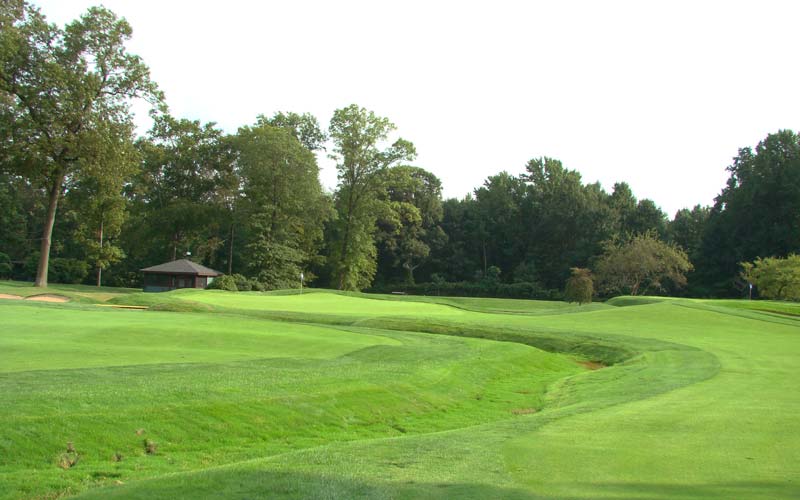
Each shot on this genuine three shotter gets progressively more challenging.

As seen from the right of the green, this humpback spines runs the length of the twelfth green, effectively dividing it into a left and right half.
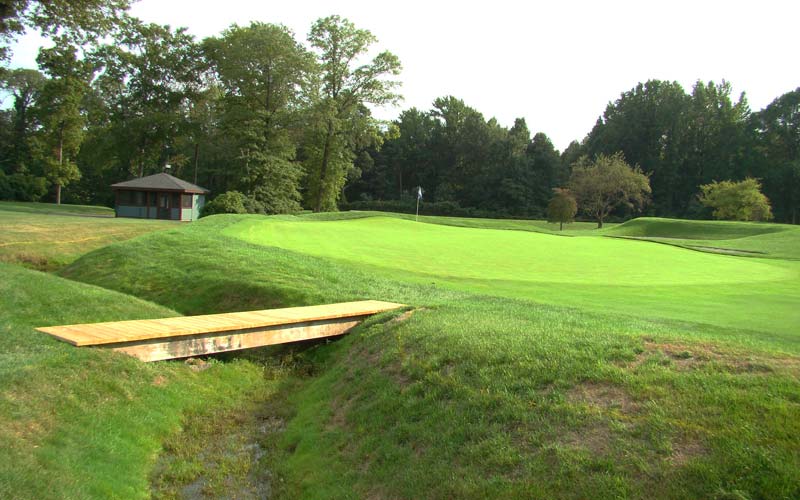
Hanse restored the size of the twelfth green by pulling it forward seven feet in the front. When such forward hole locations are used, there is incentive for the golfer to cross the stream on his second shot.
Fifteenth hole,370 yards; The three hole stretch ofthe thirteenth through fifteenth(referred to by the members as the tunnel holes) has never quite fit in with the rest of the holes, until now that is, at least for the fifteenth. The story of these three holes is somewhat convoluted but goes like this: Ross’s original1921 routing of the course was from the par 4/par 3 that is now thetwelfth hole to today’ssixteenth hole. The originalseventeenth andeighteenthholes approximately occupied the land of today’s driving range. Appreciating the need for a practice area, the Club acquired the land in the 1930swhere thetunnel holesnow reside and Ross routed these three holes from a topography map. A stream as opposed to two ponds was the dominate feature on holesthirteen andfourteen but the stream was later dammed for irrigation purposes. The actual construction of thetunnelholes was left to the golf professionalMarty O’Laughlin who was a friend of Ross’s and he did a responsible job. Nonetheless, the finishing touches of these holes were out of character with the rest of the course. Thus, the Club eventually hired Geoffrey Cornish to ‘improve’ them in the 1960s. Unfortunately, they became less like the otherfifteen holes. Hanse greatly improved the thirteenth in 2005 when a diagonal ridge was raised three feet in the fairway but as long as its green remains uncharacteristically bland, the hole will feel apart from the others. The fourteenth has seen sand-flashed bunkers replaced by mounds as per Ross’s drawings but the best work as occured at the fifteenth. The tee ball is now full of interest thanks the three fairway bunkers that were restoredon a ridge on the right and the mounds that werere-built left of the fairway. Also, Green Keeper Travis Pauley has done some of his best work here in terms of promoting fescue grasses and other vegetation, therebygiving this hole the most rustic feel of any on the course. Hopefully, his work here willbe used as template to bring such varied colors and texture across selective areas of the rest of the property.
Of the tunnel holes, the fifteenth possesses the most interesting putting surface, one that Donald
Ross himself would have been proudto have built. Note the new chipping area to the right.
Sixteenthhole, 580 yards; When combined with the twelfth, these two would surely rival the two three shotters on the second nine at Pinehurst No. 2 as thefinestpair ofpar fives found on any Rossside. Now that Hansehas restored the alternate route to the left of the Sahara like bunker complex that falls 200 yards from the tee, this three shotter is every bit the equal of the more famous Tillinghast par five found forty minutes up the highwayon the Lower Course atBaltusrol.
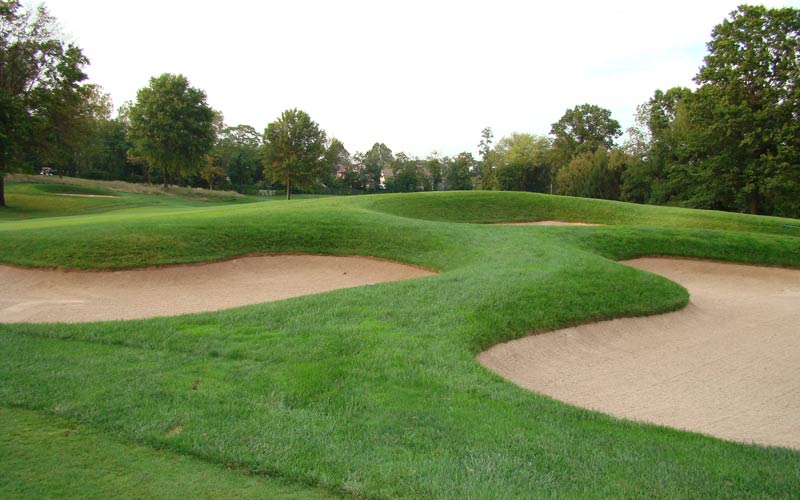
Ross placed these cross bunkers on the ridge that bisects the sixteenth fairway 200 yards from the green. Such bunkers pressure the golfer to execute on both his first and second shots, a trait found wanting with many modern three shotters.

One of the most fun shots on the course (perhaps the most fun shot) is found by clearing the central hazard and hitting a running chip shot along the ground into this severely sloping green. Rarely do long holes end with such a play on finesse.
Seventeenth&Eighteenth holes, 425 and 385 yards respectively; With only a few exceptions like the West Courses at both Royal Melbourne and Winged Foot, few courses end withtwo doglegs in the opposite direction. The horizon greens on each hole are the highlights and make depth perception tricky.
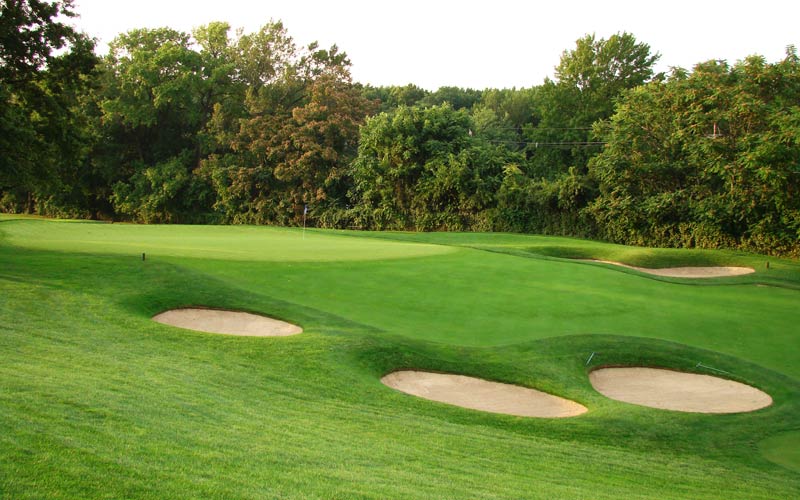
Even the caddies consider the elevated seventeenth as the hardest green to read on the course.
Even more good work is occuring at Plainfield. Two ponds were created by a long standing Green Keeper on the inside of the doglegsat thetenth and eighteenthholes due to the ground’s marshy nature. While built for practical reasons, such ponds are completely out of character on a Ross course. Thankfully, the Club has adopted Hanse’s plan to restoreRoss’s original drainage ditches onboth holes and work commences in the winter of 2009. As such fine work continues,the common theme is thatRoss’s use of the superbly rolling landis being allowed to shine through once again. And with the non-Ross features being removed and some of his lost features being restored, Plainfield will once again be regarded as one of Ross’s very best.
The End





![The Park, West Palm (Lit 9) [2023]](https://golfclubatlas.com/wp-content/uploads/2024/12/IMG_7092-2-scaled-500x383.jpg)


